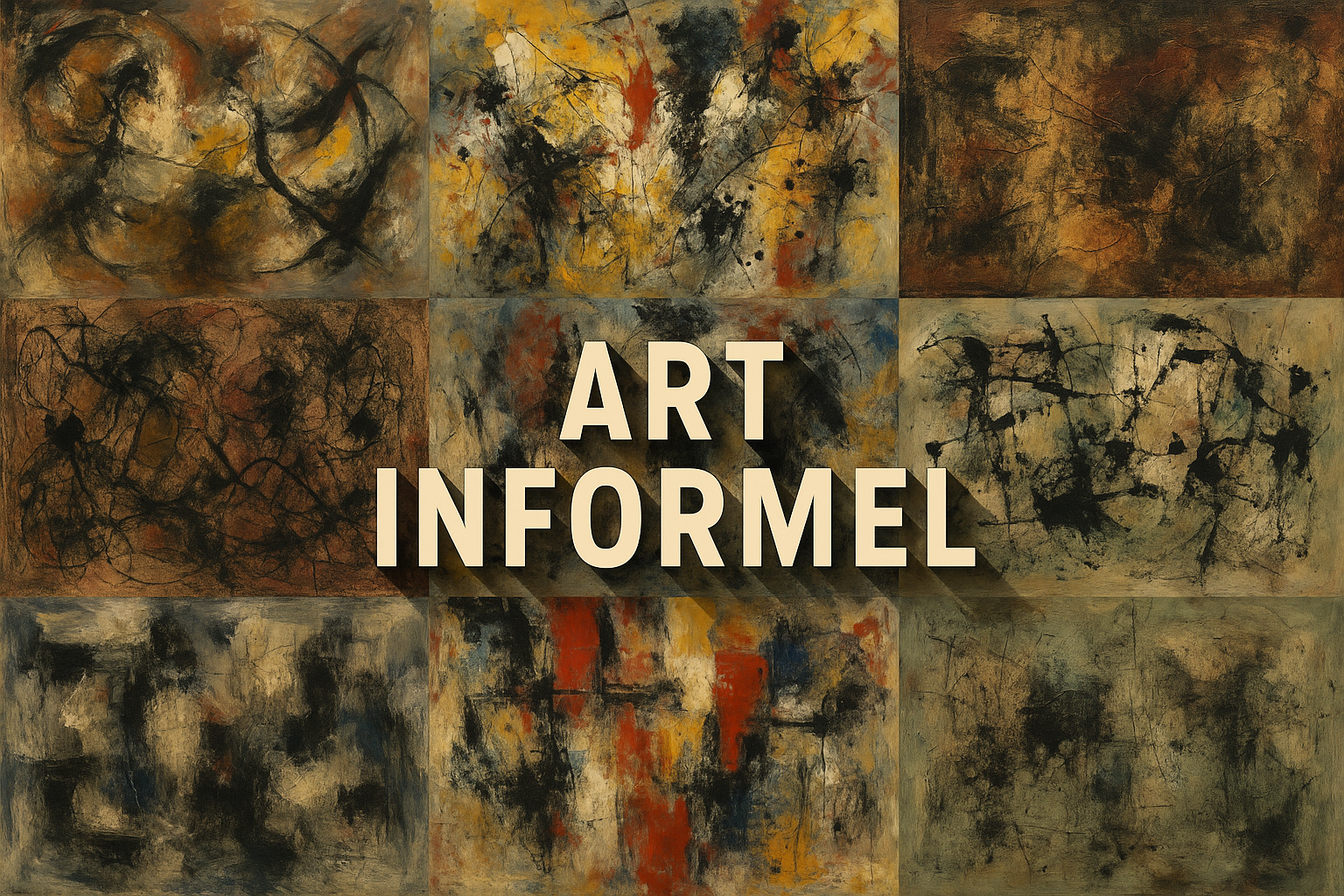
Art Informel
The art style of Art Informel is characterized by its abstract and gestural qualities. The paintings are often large in scale and have a spontaneous and expressive quality to them. The colors are often bold and vibrant, and the brushwork is often loose and gestural.
AOI thinking about Art Informel [+_~]-/
Overview and Quickfacts
Art Informel is a style of painting that emerged in the 1940s and was popularized in the 1950s. It is characterized by its spontaneity, its lack of formal structure, and its use of gestural brushstrokes. Artists associated with this style include Jean Dubuffet, Jackson Pollock, and Willem de Kooning.
Can understand it also, as:
Abstract art, non-representational art, gestural art, action painting
Categorize it as:
Impressionism, Modernism
.: Dreaming :.
holds a HAIKU for the art style
:. Thought is power .:
Detailed Description
Art Informel is a post-World War II art movement. It is characterized by its lack of a defined structure or form. The term was coined by the French critic Michel TapiÃÂé in the 1940s to describe the work of Jean Dubuffet and other artists who painted in a highly gestural and spontaneous manner. Famous artists associated with Art Informel include Jean Dubuffet, Jackson Pollock, Willem de Kooning, and Mark Rothko. One of the most famous paintings associated with Art Informel is Jackson Pollock’s “Number 1, 1948.” The painting is an abstract expressionist work that is characterized by its chaotic and gestural brushstrokes.
.. beep, beep, beep ..
<START OF TRANSMISSION>
1. Art Informel is an artistic movement that originated in the 1940s. 2. It is characterized by its spontaneity, expressiveness, and lack of formal structure. 3. The term was coined by French critic Michel TapiÃÂé in 1945. 4. The movement is associated with Abstract Expressionism and Action painting. 5. It had its origins in the work of European artists such as Pablo Picasso, Joan MirÃÂó, and Wassily Kandinsky. 6. American artists such as Jackson Pollock and Willem de Kooning were also influential in the development of the movement. 7. Art Informel was particularly popular in the 1950s and 1960s. 8. It was seen as a reaction against the rigidity of Abstract Expressionism. 9. The movement was also influenced by Surrealism and Dada. 10. Many Art Informel artists used automatic drawing and painting techniques. 11. The paintings are often characterized by their gestural quality and their use of non-traditional materials. 12. Some of the most famous Art Informel artists include Jean Dubuffet, Jackson Pollock, and Willem de Kooning. 13. The movement has been criticized for its lack of discipline and its chaotic nature. 14. Art Informel was seen as a threat to the traditional art world. 15. It has been described as "the wild child of Abstract Expressionism". 16. The term "Art Informel" is sometimes used interchangeably with "Tachisme". 17. The movement is also sometimes known as "Art Brut" or "outsider art". 18. Art Informel has had a significant influence on subsequent movements such as Abstract Expressionism, Pop Art, and Nouveau RÃÂéalisme. 19. The term "Art Informel" is derived from the French phrase "l'art sans forme". 20. The movement is also sometimes referred to as "Informalism".
<EOF>
.. robbel bob
Visual Examples from our image gallery
Coming soon, we are so slow .. might never come
Artists, Paintings, and more
(be aware, can be highly speculative)
Artists (be aware, speculation possible):
1. Hans Hartung (1904-1989) 2. Georges Mathieu (1921-2012) 3. Jean Dubuffet (1901-1985) 4. Wols (1913-1951) 5. Jackson Pollock (1912-1956) 6. Willem de Kooning (1904-1997) 7. Franz Kline (1910-1962) 8. Robert Motherwell (1915-1991) 9. Barnett Newman (1905-1970) 10. Clyfford Still (1904-1980) 11. Mark Rothko (1903-1970) 12. Adolph Gottlieb (1903-1974) 13. Helen Frankenthaler (1928-2011) 14. Morris Louis (1912-1962) 15. Kenneth Noland (1924-2010) 16. Jules Olitski (1922-2007) 17. Larry Poons (1937-) 18. Brice Marden (1938-) 19. Sam Francis (1923-1994) 20. Paul Jenkins (1923-2012) 21. Joan Mitchell (1926-1992) 22. Ray Parker (1922-1990) 23. Norman Bluhm (1921-1999) 24. Joan Snyder (1940-) 25. Ronnie Landfield (1947-) 26. Peter Reginato (1949-) 27. Joe Zucker (1951-) 28. Robert Rauschenberg (1925-2008) 29. Cy Twombly (1928-2011) 30. Jean-Michel Basquiat (1960-1988)
Artworks (be aware, speculation possible)
1. “The Red Painting” by Jackson Pollock, 1950 2. “Number 1, 1950” by Jackson Pollock, 1950 3. “Number 3, 1950” by Jackson Pollock, 1950 4. “Number 4, 1950” by Jackson Pollock, 1950 5. “Number 5, 1948” by Jackson Pollock, 1950 6. “Number 7, 1951” by Jackson Pollock, 1951 7. “Number 11, 1952” by Jackson Pollock, 1952 8. “Number 12, 1952” by Jackson Pollock, 1952 9. “Number 14, 1952” by Jackson Pollock, 1952 10. “Number 17A, 1948” by Jackson Pollock, 1948 11. “Number 18, 1951” by Jackson Pollock, 1951 12. “Number 19, 1951” by Jackson Pollock, 1951 13. “Number 20, 1951” by Jackson Pollock, 1951 14. “Number 23, 1952” by Jackson Pollock, 1952 15. “Number 25, 1953” by Jackson Pollock, 1953 16. “Number 27, 1953” by Jackson Pollock, 1953 17. “Number 28, 1954” by Jackson Pollock, 1954 18. “Number 30, 1954” by Jackson Pollock, 1954 19. “Number 32, 1954” by Jackson Pollock, 1954 20. “Number 34, 1955” by Jackson Pollock, 1955 21. “Number 1A, 1948” by Jackson Pollock, 1948 22. “Number 1, 1957” by Jackson Pollock, 1957 23. “Number 3, 1957” by Jackson Pollock, 1957 24. “Number 4, 1957” by Jackson Pollock, 1957 25. “Number 5, 1957” by Jackson Pollock, 1957 26. “Number 6, 1957” by Jackson Pollock, 1957 27. “Number 7, 1958” by Jackson Pollock, 1958 28. “Number 8, 1958” by Jackson Pollock, 1958 29. “Number 9A, 1959” by Jackson Pollock, 1959 30. “Number 9, 1959” by Jackson Pollock, 1959
Epoch
The Art Informel movement began in the 1940s and ended in the 1950s.
AI ART RESSOURCES (AKA, well Tools)
Helping tools -> predefined search links on other pages:











